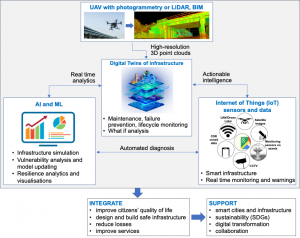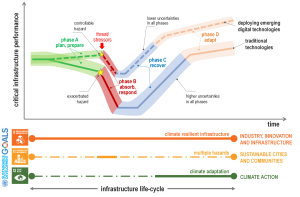2022 EC3 Thorpe Medal winner Dr Sotirios Argyroudis explains the exciting opportunities and roles of digital twins, IoT and machine learning in enhancing critical infrastructure resilience and sustainability
A digital twin is a digital or virtual replica of an infrastructure asset (the physical twin), for example, a bridge or a system eg, or part of a railway network. A digital twin can be created by gathering data from BIM and UAV photogrammetry. A digital twin transmits data, monitors the asset in real-time and supports analytics, control and simulation functions, also by employing machine learning (ML) and/or AI (Figure 1).
Today, digital twins, in conjunction with AI, enable dynamic and adaptive modelling of hazard impacts on infrastructure, as well as automated and intelligent identification of structural, deterioration and damage.
The opportunities and benefits of digital twins are endless. Digital twins can reproduce the interdependencies between assets or systems to improve our understanding of infrastructure performance, for example, under different hazard scenarios. This facilitates infrastructure management and enhances infrastructure resilience throughout its lifecycle.
Digital twins, in conjunction with other data from eg satellite imagery, can facilitate rapid decision-making as they can provide accurate and reliable assessments compared with conventional approaches. This can enable early warnings, which can support the reaction of infrastructure operators before a critical level of performance loss is reached. Also, a digital twin can be used to manage, maintain and retrofit the physical asset. As an example, this technology was used in the assessment of the landmark Polyfytos bridge in northwest Greece.

Internet of Things and machine learning for infrastructure resilience
IoT represents the connection over the internet of digital and physical objects, such as smartphones, transport infrastructure or energy assets and users by means of suitable information exchange, that enables data collection, communication, and processing and leads to actionable intelligence for a range of applications, services and decision-making.
IoT sensors and devices enable today’s real-time monitoring of data on infrastructure such as water level, traffic conditions and environmental impacts and provide early warnings.
They also can enable automated diagnosis and autonomous recovery mechanisms, for example, to isolate faulty components and redistribute power in case of energy systems. In case of disasters, such as a flood or wildfires, IoT can be used to identify safer evacuation routes and inform citizens. In this way, digital technologies can make people feel safer.
Hazard and vulnerability models can be used to define the likelihood of infrastructure failures, for example in case of earthquakes or floods, and this can help civil protection authorities and infrastructure operators to take proactive measures to minimising losses.
Data from past infrastructure failures combined with monitoring data (eg wind, traffic flow or moisture on the structure) can be used to train predictive algorithms using ML. In this way, we can improve the accuracy and reliability of vulnerability, resilience and sustainability models for future infrastructure performance under different hazard conditions, eg considering climate projections.
These technologies can transform infrastructure management and decision-making, and revolutionise the readiness of infrastructure operators.

Phases of infrastructure resilience
Infrastructure resilience is typically represented through four phases of the infrastructure lifecycle, which include:
Phase A: Planning and preparation during normal and deteriorating conditions, and before the hazard occurrences (eg a flash flood or an earthquake).
Phase B: Absorption and response during and immediately after the hazard event.
Phase C: The recovery of the infrastructure functionality due to damage.
Phase D: Infrastructure adaptation, eg to new stressors due to climate exacerbations.
Infrastructure resilience is enhanced in all phases by employing digital technologies such as digital twins, ML and IoT, in comparison with conventional infrastructure management, such as visual inspections (Figure 2).
At the same time, the uncertainties around resilience assessments are reduced due to more accurate simulations based on continuously updated data and models. This is also in support of critical UN SDGs such as SDG9 (climate-resilient infrastructure), 11 (sustainable and resilient cities to multiple hazards) and 13 (efficient adaptation to climate change).
This article is based on the open-access paper by Argyroudis SA, Mitoulis SA, Chatzi E, Baker JW, Brilakis I, Gkoumas K, Vousdoukas M, Hynes W, Carluccio S, Keou O, Frangopol DM, Linkov I (2022). Digital technologies can enhance climate resilience of critical infrastructure. Climate Risk Management, 35, 100387 https://doi.org/10.1016/j.crm.2021.100387. This paper was awarded the 2022 Thorpe Medal of the European Council on Computing in Construction- EC3.
The Thorpe Medal was instituted and endowed in 2018 in the honour of Prof Antony Thorpe, a pioneering professor in construction information technology and co-founder of COMIT the community for mobile computing in construction. The Thorpe Medal recognises a paper that contributes to practical and/or research aspects of engineering informatics disciplines in the built environment.
The full paper is available here.
Dr Sotirios Argyroudis
Assistant professor in infrastructure engineering
Brunel University London
Tel: +44 (0)1895 267728
sotirios.argyroudis@brunel.ac.uk













